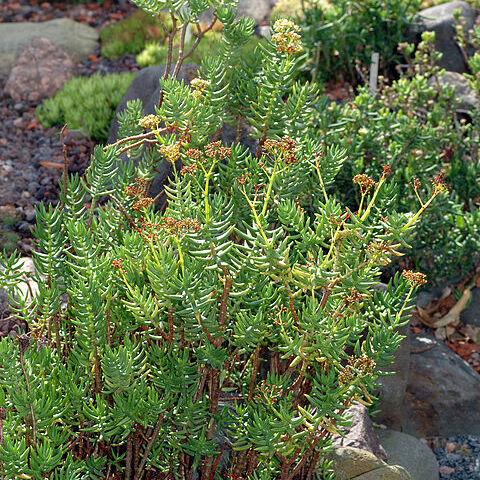Erect, glabrous subshrub 15-40-(50) cm high; stems 5-10 mm thick, becoming woody. Lvs sessile, decussate and ± imbricate but internodes clearly visible, not forming terminal rosettes, 13-33 × 6-8 mm, 4-6 mm thick, subterete with upper surface flattened and lower surface ± rounded, slightly angular, deep green, lacking hydathodes, ± upturned and falcate; apex acute. Infl. a ±rounded thyrse, somewhat corymbose, 2-5 cm across; main axis with small bracts. Fls 5-merous, 3-5 mm diam., usually numerous, subsessile or on pedicels to 3 mm long. Calyx 0.7-1 mm long; lobes broadly ovate or oblong-ovate. Corolla not star-like; petals free, spreading, 2-3 × 1-1.3 mm, elliptic-ovate or oblong-ovate, white, reflexed. Stamens and carpels (including styles) c. 2.5 mm long. Scales very small, semi-lunate. Seeds not seen and fls not replaced by plantlets in infl.
Perennial dwarf shrub, succulent, much branched, erect to decumbent, carnose to woody stems up to 50 mm in diam., ± 0.8-1.0 m high, smooth, rarely peeling or flaking bark on older branches, old leaves deciduous. Leaves sessile, lanceolate, 8-50 x 1-4 mm, acute, dorsiventrally flattened to terete, green, grey bloom. Inflorescence a flat-topped dichasium, few to many pedicellate flowers; peduncle 10-150 mm long. Calyx acute, fleshy, green tinged reddish brown. Corolla tubular, scarcely fused, cream-coloured; lobes elliptic to oblanceolate, 1-2 mm long, acute, dorsal ridge, recurved. Flowering time Jan.-Mar.
Woody or fleshy, branched perennial, with erect to prostrate branches, often with peeling bark on older stems, 0.1-1 m tall. Leaves sessile, lanceolate, dorsiventrally compressed to terete, 8-80 x 1-4 mm. Flowers in a rounded to flat-topped cluster on a glabrous peduncle 10-150 mm long with internodes usually longer than those of stem, tubular, petals 1-2 mm long, fused only at base, with a small, subterminal appendage, cream or white.
Plants terrestrial, perennial. Stems erect, green, moderately branched, 30-50 cm. Leaf blades linear to triangular, 10-30 mm, apex mucronate. Inflorescences lax, flowers 2 per node. Pedicels 3-5 mm. Flowers 5-merous; sepals (erect), triangular, 1 mm, apex acute; petals narrowly triangular, 2-3 mm. Follicles erect, 6-10-seeded, ovoid; old follicles erect, boat-shaped. Seeds not seen.
Perennial to 1 m, with erect to spreading, sometimes papillate branches. Leaves opposite, lanceolate, sometimes rounded in section. Flowers in flat-topped clusters, tubular, cream-coloured, sometimes white, petals ± 3 mm long.

